Mirror, Mirror
By Samantha Mocle
By Samantha Mocle
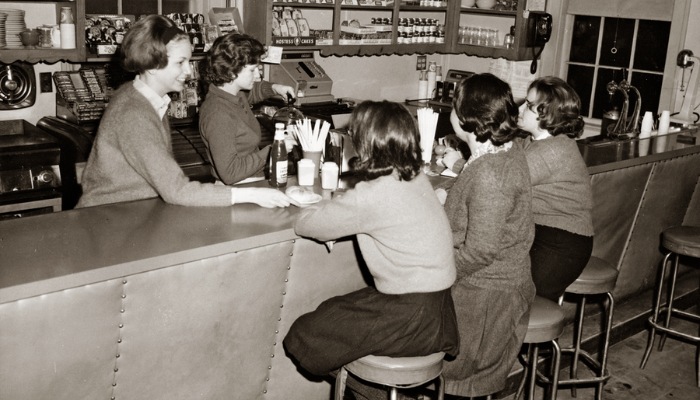
Young women walk down Woodland Road with Lasell class beanies pinned to their pompadours. They’re on their way to the Barn for a soda at the snack bar before heading to class, where they’ll spend the next few hours honing their skills at the manual typewriter for their medical secretary program. Tonight, they’ll dine in Carpenter House for a friend’s home economics dinner party presentation before rushing back to Chandler House to make curfew.

Students walk down Woodland Road in their University gear on the way to the Arnow Campus Center. They grab food from 1851 before heading to class, where they’ll spend the next few hours studying trace evidence and microscopy techniques for their forensic science program. Tonight, they’ll bounce from internships to team practices and club meetings before heading back to Chandler House before 1 a.m. … if they feel like it.
As times change, so do we. Some might say we have a crystal ball … but for those who truly know Lasell, they understand that a flexible mindset is in our DNA. For 173 years, we’ve adapted campus and curricular offerings to stay ahead of trends while holding true to our core values. When we see a need, we are among the first to address it—whether it’s through paths of study, innovative partnerships, or social resources to support our students and community.
Post-war America needed nurses, and fast. A plethora of four-year, classroom-based programs existed, but Lasell Junior College understood the need to provide students with more clinical experience on a tighter timeline. The institution launched the first two-year associate’s degree registered nurse (RN) program in New England in 1954.
“You could go to a two-year school that taught to the exam, but that is all it would prepare you for,” says Debby Lind Mahony ’67, a retired nursing educator and current Lasell trustee. “Someone going into hospice care, community health, or public health needs more than that. Lasell provided the comprehensive instruction and intensive clinical experience that the industry demanded.”
Susan Miller-Havens ’65 and her peers saw that preparation in action when they encountered graduates of other nursing programs on a ward.
“The difference was that from the get-go we were immersed in clinical experiences,” says Miller-Havens. “At 17 years old, we were going to the Brigham hospital wards and caring for acutely ill patients.”
By then, Lasell had expanded its program to a three-year degree. Other programs, she adds, “theoretically had more years of education, but how do you define education? They were paralyzed and terrified of the clinical work.” Adds Marsha Graziano Ballantyne ’64, “We had great experiences that four-year programs did not get.”
Through their courses and clinicals, recalls Joan Snipes Bigelow ’65, they graduated with job offers in hand. Part of that, says Deirdre Hanley McGrath ’64, was Lasell’s progressive approach to nursing. In a job market saturated with theoretical practitioners, graduates of Lasell’s program were highly valued.
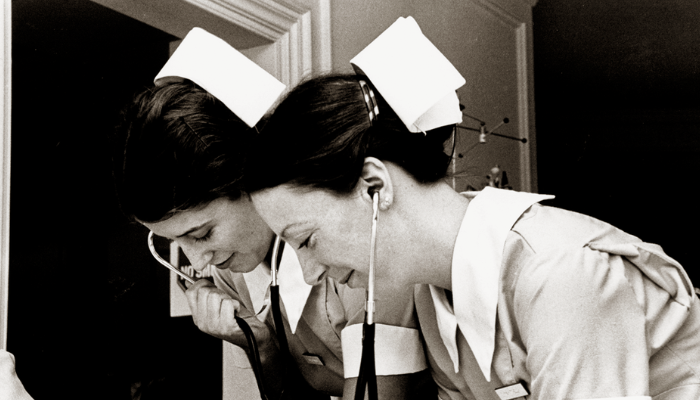
“We never lost sight of the whole person. In those days it was very much about the technical work,
but Lasell taught us to address the mind and body," says McGrath.
From a higher education perspective, there are not a lot of institutions willing to do that kind of thinking, says Cristina Haverty, associate vice president of workforce development and global engagement.
“We have always been nimble and open-minded about how we approach things. It can take years to set up these kinds of programs at other schools, whereas we build on the synergy and momentum of the moment.”
For Lasell and Newton-Wellesley Hospital, that moment grew from the need for surgical technologists—particularly after peak COVID years.
“The hospital recognized an opportunity to retain employees with potential by partnering with an educational institution to get folks prepared and in the field,” says Jessica Cerbo, Newton-Wellesley surgical technologist and Lasell program chair.
Haverty and counterparts at Newton-Wellesley used market analysis data to understand what skills and knowledge graduates of the surgical technology program would need, and then created a curriculum and courses to match. The first cohort of students graduated in December 2023.
The program is a testament to Lasell’s core values, says Haverty. Much like the RN program, it was created to not only fulfill workplace demand, but to give its students social mobility.
“It changed my life,” says Elvis Bukenya ’24, a recent graduate of the surgical technology program. “I have stability, the money is good, and I go into the operating room every shift feeling confident in my abilities.”
The real key, says Cerbo, is that the program “takes down the barriers for people who have the skills and potential to change the trajectory of their lives.” Haverty agrees, noting that Lasell has never been interested in competing in oversaturated markets.
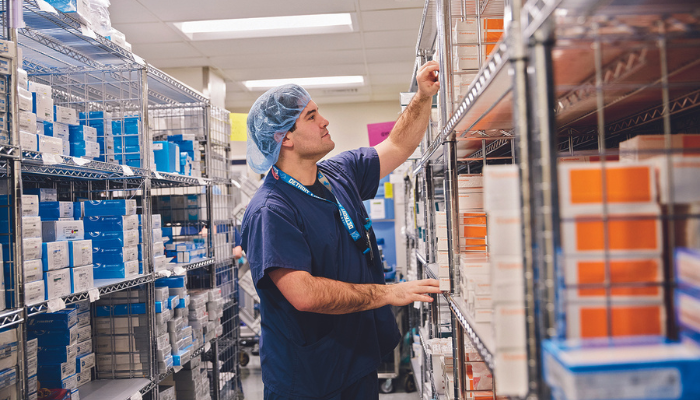
Connected Learning at Lasell goes beyond linking classroom study with professional practice; it also means syncing our academic programs with market demand and understanding that constant evaluation (and evolution) is how we can best prepare our students for the workforce.
Kristin Kinsky ’93, associate professor of fashion, is proud that Lasell’s fashion merchandising program has thrived for 85 years.
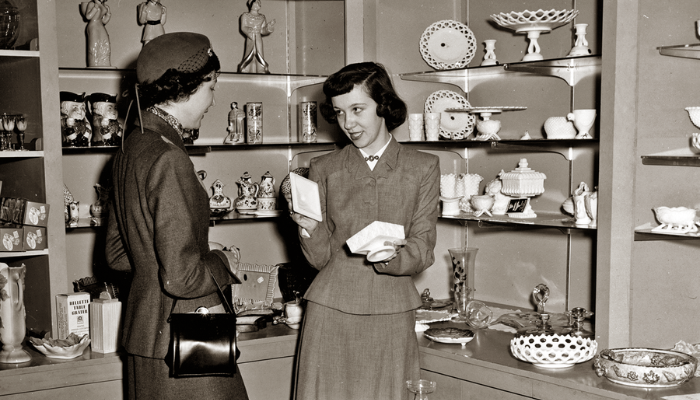
First offered as part of home economics in the 1930s, the retailing program incorporated courses in personnel management, buying practices, labor relations, and psychology of personality in the 1960s. It evolved again in the 1990s to address growing trends in marketing, retail organization, advertising, sales, and visual merchandising.
As students, Kinsky and her peers created store displays on Newbury Street and in Copley Square, and produced annual RUNWAY shows in what is now de Witt Hall. As a faculty member, she now trains students for roles on a much larger scale.
“I remember learning about lighting and store layout in my visual courses. Now our students are in corporate situations involving product development, event management, and assortment planning, and all with a bigger impact,” she says. Students visit trade shows, showrooms, trend forecasting centers, and more to learn about the global state of fashion as it relates to burgeoning topics such as AI, human rights, gender identity, ecommerce, and sustainability. RUNWAY is now entirely student-produced and is a two-day, 1,200-person affair in the University’s Athletic Center.
“You do the work. It’s as real as it gets,” says Kinsky. Fashion and retail merchandising is ever evolving with new technology. Where some might see a burdensome challenge, Kinsky and her colleagues see opportunity, leveraging their industry connections to anticipate trends and asking students to do the same.
“We instill knowledge based on our years of experience and research, but we also enjoy the journey of discovery and learning alongside students as we move into the future of fashion,” she says.
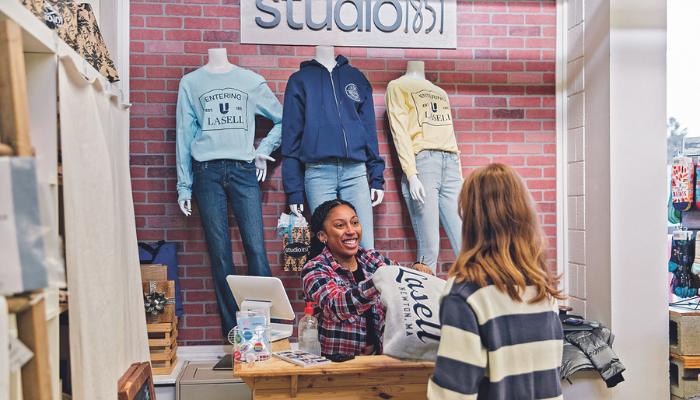
Adapting alongside students shows them the value of maintaining an open mind on the job and demonstrates that success in a dynamic field like fashion comes from a commitment to lifelong learning.
In the case of hospitality, early versions of Lasell’s program utilized an on-campus bed-and-breakfast and travel agency for Connected Learning experiences.
Nicole Positano White ’96 found that she was more prepared than industry peers for her job as a hotel manager with the U.S. Air Force just months after graduation.
“Most people were only familiar with how to work the front desk, but I could do the work to prepare rooms, plan events, all of it,” she says. Working at the Lasell Inn prepared her to think about the many intricate details of hospitality that can’t be learned in the classroom. “That experience has played a role in everything I’ve done since graduation.”
Crista Cannata Jones ’04 also found herself in an advantageous position in the travel and tourism job market thanks to a workforce-aligned curriculum. In her reservations classes, she visited the Delta call center at Logan Airport and learned how to use SABRE, an industry-standard system used by major airlines.
“I didn’t have to do much training in my first job because SABRE was taught to us at Lasell,” she says. Even as systems evolved, Jones found that she could stay ahead of the curve thanks to the initial advantage she had post-graduation.
“I’ve been working as a travel agent for 19 years and that knowledge still helps me today,” she says.
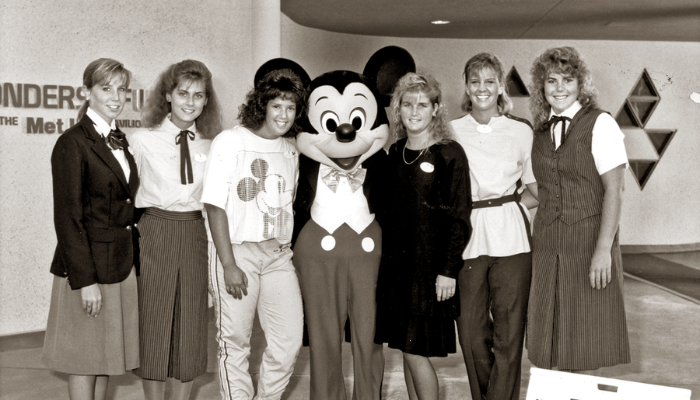
The travel and tourism major of the early 2000s has evolved into a hospitality and event management program reflective of today’s jobs—and will continue to morph as the market does.
Siddharth Mobar, associate professor of hospitality and event management, incorporates American Hotel and Lodging Association (AHLA) certifications into his curricula to “stay in sync with what the lodging industry is looking for.” When employers post jobs, he says, they ask for a specialized skill set that these credentials provide.
“It puts our students in a different category altogether,” he says.
Dina Tanvuia, associate professor and chair of the hospitality program, recognizes that a classroom reflective of a dynamic industry requires change in the way she teaches. “That’s how you prepare students for the future,” Tanvuia says. In the past five years, she has brought students to Las Vegas for meetings with luxury hotel and casino executives, helped ink an internship partnership between Lasell and Encore Boston, and positioned the University as a leader within the Professional Convention Management Association (PCMA).
Up next for her and her students? Artificial intelligence. This semester, she invited the developer of a new AI app, Spark, to speak in her classes and do a demo of the emerging technology. “The industry is using it, so we need to be, too. We need to reframe our teaching toward whatever is up and coming.”
Change is great … but when it comes to our community, students benefit from an unwavering commitment to inclusivity and belonging.
Mid-century Lasell welcomed students—and particularly “Day Hops,” or commuters—to the Barn as a place to connect outside the classroom. Shirley Vara Gallerani ’53 appreciated the designated location for students like her who didn’t live in the dorms, but never felt that she and her friends were separate from residential students.
“There was never a division or a feeling that you didn’t belong. You just got to know people and became part of their Lasell life, and they yours,” she says.
Christina Gonzalez ’25 appreciates today’s Intercultural Center and Commuter Cottage (IC3) as a place to “connect with people about anything, not just school stuff.” She transferred to Lasell from Bunker Hill Community College last year and is already leading efforts to further incorporate commuters into campus life. The IC3, much like the Barn in Gallerani’s day, is a home away from home for students like her.
“It is so helpful to have a place of no judgment and people to help you find your way. I want to build a commuter community that embraces their place on campus,” she says.
Adds Gallerani, “Getting to know people from other courses, cultures, and clubs is part of your education.”
Diane Bourbeau ’03 and Victor Cipolla ’03 cofounded Lasell’s Bisexual, Lesbian, Gay, and Transgender Alliance (BILAGA) as students in the early 2000s.
“I felt like I was welcomed with open arms when I arrived on campus,” says Cipolla. “It was the first time in my life that I belonged to a group that I felt safe in.” He and Bourbeau started BILAGA as a grassroots effort to give students a comfortable place to talk about anything in the world, including their sexuality.
Ceci Wood ’24 is keeping the tradition alive today with her recent founding of Queer on Campus. Her first Lasell PRIDE meeting was “life changing,” but left her feeling like there was room for another queer outlet.
“I wanted to create a space that didn’t have an agenda or events but was truly just a safe affinity space to show up and talk about anything,” she says of Queer on Campus. “The idea isn’t to make people identify themselves as anything, it’s to tell them that they belong, period.”
That message spoke volumes to Wood, a transfer student, when she arrived on campus (“It was so accepting here that it scared me,” she recalls); and rang true for Bourbeau in 1999, as well.
“I hope that students today have the same kind of experience I did,” she reflects, “because I am who I am and that is because Lasell molded me into an inclusive, complete human.”